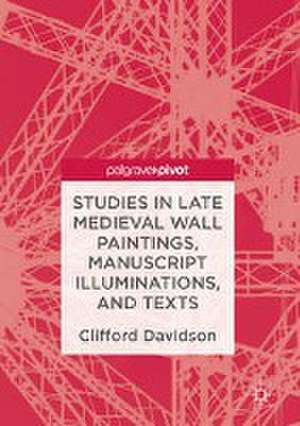Studies in Late Medieval Wall Paintings, Manuscript Illuminations, and Texts
Autor Clifford Davidsonen Limba Engleză Hardback – 28 dec 2016
| Toate formatele și edițiile | Preț | Express |
|---|---|---|
| Paperback (1) | 411.54 lei 6-8 săpt. | |
| Springer International Publishing – 13 iul 2018 | 411.54 lei 6-8 săpt. | |
| Hardback (1) | 420.40 lei 6-8 săpt. | |
| Springer International Publishing – 28 dec 2016 | 420.40 lei 6-8 săpt. |
Preț: 420.40 lei
Nou
Puncte Express: 631
Preț estimativ în valută:
80.44€ • 84.21$ • 66.56£
80.44€ • 84.21$ • 66.56£
Carte tipărită la comandă
Livrare economică 05-19 aprilie
Preluare comenzi: 021 569.72.76
Specificații
ISBN-13: 9783319474755
ISBN-10: 3319474758
Pagini: 170
Ilustrații: IX, 138 p. 9 illus., 7 illus. in color.
Dimensiuni: 148 x 210 mm
Greutate: 0.4 kg
Ediția:1st ed. 2017
Editura: Springer International Publishing
Colecția Palgrave Macmillan
Locul publicării:Cham, Switzerland
ISBN-10: 3319474758
Pagini: 170
Ilustrații: IX, 138 p. 9 illus., 7 illus. in color.
Dimensiuni: 148 x 210 mm
Greutate: 0.4 kg
Ediția:1st ed. 2017
Editura: Springer International Publishing
Colecția Palgrave Macmillan
Locul publicării:Cham, Switzerland
Cuprins
Preface.- 1. The Coventry Holy Trinity Doom Painting: Anticipating the End-Time.- 2. Image, Text, and Devotion in Carthusian Wall Painting, Manuscript Illumination, and Narrative.- Coda: Everyman: Participating in Symbols of Death.
Notă biografică
Clifford Davidson is Professor of English and Medieval Studies Emeritus at Western Michigan University. He has written voluminously on medieval drama, iconography and the visual arts, and medieval and early modern literature. He was director for a quarter century of the Early Drama, Art, and Music project in the Medieval Institute. His most recent book is Corpus Christi Plays at York: A Context for Religious Drama and, in collaborations with Martin Walsh and Ton Broos, an edition of Mary of Nemmegen, with the original Dutch play upon which it was based.
Textul de pe ultima copertă
This volume is an interdisciplinary consideration of late medieval art and texts, falling into two parts: first, the iconography and context of the great Doom wall painting over the tower arch at Holy Trinity Church, Coventry, and second, Carthusian studies treating fragmentary wall paintings in the Carthusian monastery near Coventry; the devotional images in the Carthusian Miscellany; and meditation for “simple souls” in the Carthusian Nicholas Love’s Mirror of the Blessed Life of Jesus Christ. Emphasis is on such aspects as memory, participative theology, devotional images, meditative practice, and techniques of constructing patterns of sacred imagery.
Clifford Davidson is Professor of English and Medieval Studies Emeritus at Western Michigan University. He has written voluminously on medieval drama, iconography and the visual arts, and medieval and early modern literature. He was director for a quarter century of the Early Drama, Art, and Music project in the Medieval Institute. His most recent book is Corpus Christi Plays at York: A Context for Religious Dramaand, in collaborations with Martin Walsh and Ton Broos, an edition of Mary of Nemmegen, with the original Dutch play upon which it was based.
Clifford Davidson is Professor of English and Medieval Studies Emeritus at Western Michigan University. He has written voluminously on medieval drama, iconography and the visual arts, and medieval and early modern literature. He was director for a quarter century of the Early Drama, Art, and Music project in the Medieval Institute. His most recent book is Corpus Christi Plays at York: A Context for Religious Dramaand, in collaborations with Martin Walsh and Ton Broos, an edition of Mary of Nemmegen, with the original Dutch play upon which it was based.
Caracteristici
Focuses on the iconography and context of the great Doom wall painting over the tower arch at Holy Trinity Church, Coventry Discusses Carthusian studies: fragmentary wall paintings in the Carthusian monastery near Coventry Explores the devotional images in the Carthusian Miscellany and meditation for “simple souls," rather than for a monastic audience
